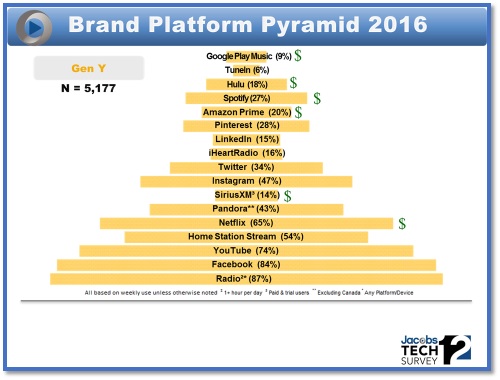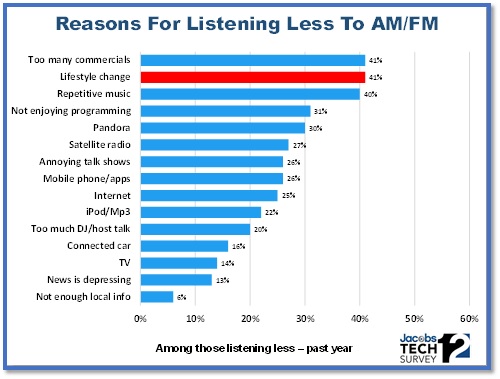 Everyone is diving into the subscription media business. Except radio. And that’s a good thing.
Everyone is diving into the subscription media business. Except radio. And that’s a good thing.
For just a few dollars each month, you can subscribe to Spotify, Apple, Google or Tidal, buy Pandora One, sign up for Netflix, access Hulu, dive into HBO Go, and pay for Amazon Prime. And let’s not forget that if you hold out a bit, you can get a really low monthly payment from Sirius/XM.
The list goes on, and now SoundCloud has announced that it, too, has jumped into the subscription pool…for the low, low price of just $10 per month.
You can see the signs of all this media subscribership on our new Techsurvey12 “Brand Platform Pyramid.” The one below zooms in on Millennials, many of whom may be struggling to make ends meet, pay off their student loans, nail down that full-time job, and get their adult lives off the ground. Somehow despite these financial pressures, substantial groups of twentysomethings are spending considerable dollars to entertain and inform themselves.

There are dollar signs next to services that require monthly subscriptions – Netflix, Hulu, Spotify, and others. Two-thirds access Netflix weekly, more than a quarter connect with Spotify. About a fifth have bought into Amazon Prime Music.
Millennials – almost always more than Boomers or Gen Xers – are paying out monthly fees for a number of these entertainment services. Several others – like YouTube, Pandora, and TuneIn – have “premium” packages, but these are optional so I did not designate them.
Why has the subscription model become so popular, and what are all these brilliant marketers thinking? Sustainable, scalable revenue is the secret to digital media success – or so it seems. Millennials may not want to shell out big money all at once for their media, but a few bucks seamlessly deducted from their debit card each month seems pretty painless, except it adds up.
Think public radio. They’re cashing in on the trend, continuing to move their loyal listeners away from an annual membership structure, and into “sustainer” programs that have proved to be the gift that keeps on giving. If they’re able to amass enough of these, maybe pledge drives will finally go away. One can only hope.
Of course, these monthly fees are for content. Then there are the distribution fees – WiFi, data plans for smartphones – that also keep expenses for those who can least afford it very high. But that’s the nature of the world in which we live. And of all the generations, Millennials are most apt to buy into that.
If you want content and distribution, you have to pay for it. Except for radio.
Against the rapidly growing subscription wave, it’s the medium that is free, easy to use, requires no password, user name, acceptance of terms, a credit or debit card on file, an email address, or a WiFi connection.
And yet, radio never makes its case in this increasingly crowded audio space. While many people intrinsically understand radio’s business model, it is never stated, marketed, or promoted. Figure it out for yourselves.
Most consumers realize there’s a price to be paid for “regular radio” – and they’re called commercials. In our latest Techsurvey, we created a pecking order of perceived radio negatives among the 10% of our sample who say they’ve been listening less in the past year. The list is predictable, but also telling:

Once you get beyond lifestyle changes (a move, change in job, etc.), it’s a dead heat between commercials and music repetition. External factors – Pandora, SiriusXM, apps, smartphones and other digital channels – play a role, but fall behind radio’s programming and advertising policies.
And the fact is, many more respondents say they’re listening to more radio in the past year. And when we zoom in and look at people in TS12 who spend an hour a day with radio, the numbers are quite stable at 92%. That’s a very good thing.
Like all other traditional media – TV, newspapers, and magazines – radio is being profoundly challenged by new options and a changing consumer culture of entertainment and information. But within this media mélange, broadcast radio has distinct, marketable, differentiating advantages.
Rather than hoping that consumers, advertisers, and marketers “get it,” isn’t it time to aggressively promote radio’s unique selling propositions, at a time when new media brands have gained control of the conversation?
It’s been so long since most radio stations have advertised that the industry has forgotten the value and importance of marketing and why it matters. Radio truly has a unique and compelling story.
Everyone’s diving into subscription music. Except radio. And that’s a good thing.
It’s time to tell it.
The top-line findings of Techsurvey12 will be presented next week at the Worldwide Radio Summit in L.A. It’s a great conference, chock-filled with great sessions, panels, and keynotes, presented by some of media’s biggest stars. Information here.
- What To Do If Your Radio Station Goes Through A Midlife Crisis - April 25, 2025
- A 2020 Lesson?It Could All Be Gone In A Flash - April 24, 2025
- How AI Can Give Radio Personalities More…PERSONALITY - April 23, 2025




Yet again, Jacobs Media brought it home! Great content and insight for radio broadcasters and the latest trends in the space! Keep it coming Jacobs Media. #JusticeBeat @justicebeat2day
We appreciate the kind comments. Thanks for reading our blog.
Great, Great blog this morning. You hit it out of the park.
Here’s the :30 (with the permission of Jacobs Media of course)
Zero down………Zero per month, RADIO, It’s free, easy to use, requires no password, user name, credit or debit card, email address, or WiFi connection. That’s why 92 percent of Americans listen each week. 103.9 WLEN, it’s the news, information and entertainment you want and need, no subscription required.
Send me the audio! This is great, Julie – thanks for jumping on this.
Your comments about marketing of course, struck a major nerve with me today.
You know what happens when you DON’T market … NOTHING!
The old adage of “out of sight, out of mind” is becoming more a reality
in radio every day.
Investing in your brand can only lead to good things and it sends a strong
message to both your clients and your audience, we’re here to stay!
How can we find a balance where radio wakes up and embraces the need to market once again???
Good question, David. As an industry, there’s an incredible marketing machine. It’s about putting that 93% megaphone to work.
A point missed in this discussion that is extremely important to recognize going forward is the model that SoundCloud offers. Yes, it has created a subscription service, with an incredibly different edge than the other subscription services that were mentioned. Spotify, iTunes, Tidal and others promote music that has been created and marketed by conglomerates, BMG, Sony Music, EMI, etc. It is this mass marketed product that will give SoundCloud the edge.
Soundcloud provides a platform for creators to publish directly to an audience. This has the potential to cause a profound shift in the consumption of music.
I am a music creator. I publish my work on SoundCloud. It is available to everyone for FREE. Think about that.
https://soundcloud.com/user-280675271-76482290
Christopher, thanks for the comment. I did not intend to besmirch SoundCloud, but was just pointing out that like so many others, they now feature a subscription model, too. It’s about survival of these services. The only way they can continue to provide this service to you is to obviously rethink their business model. Best of luck, and thanks for reading our blog.